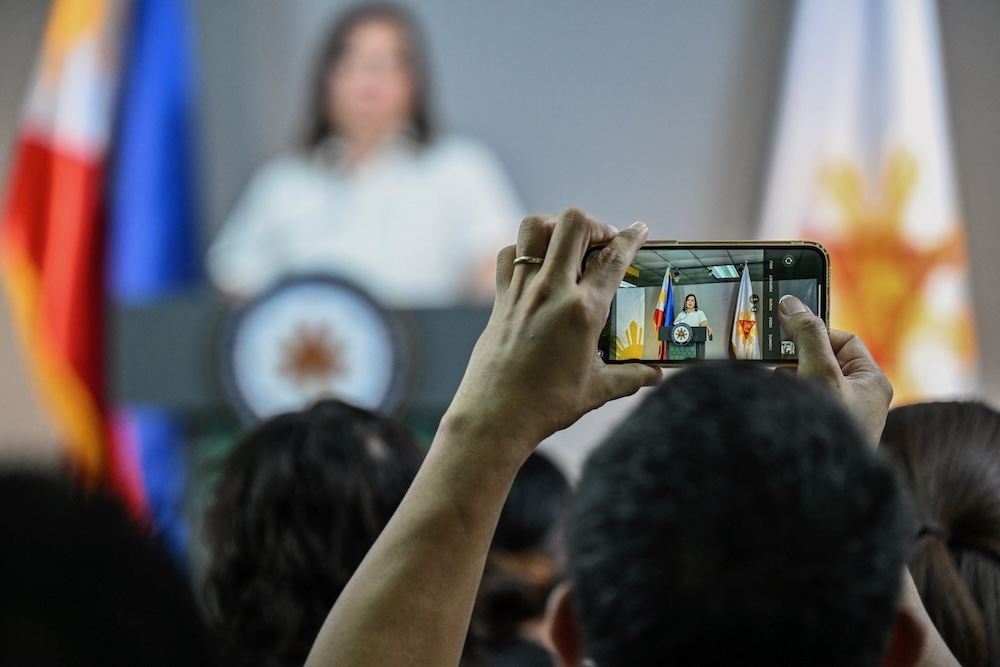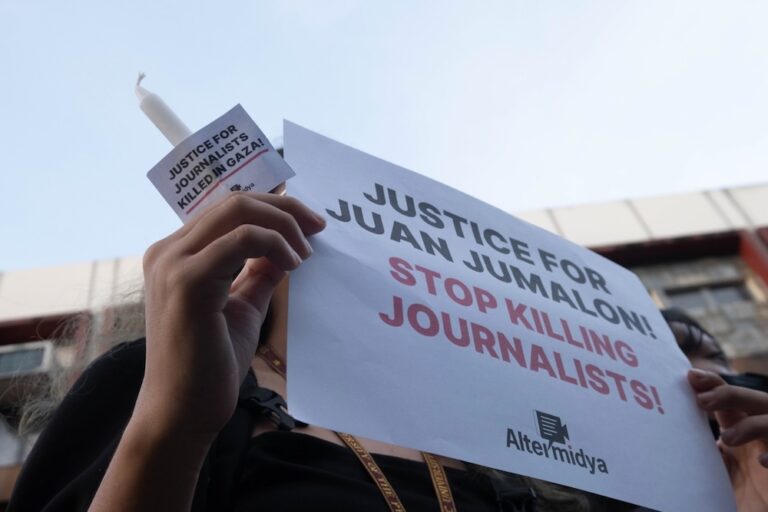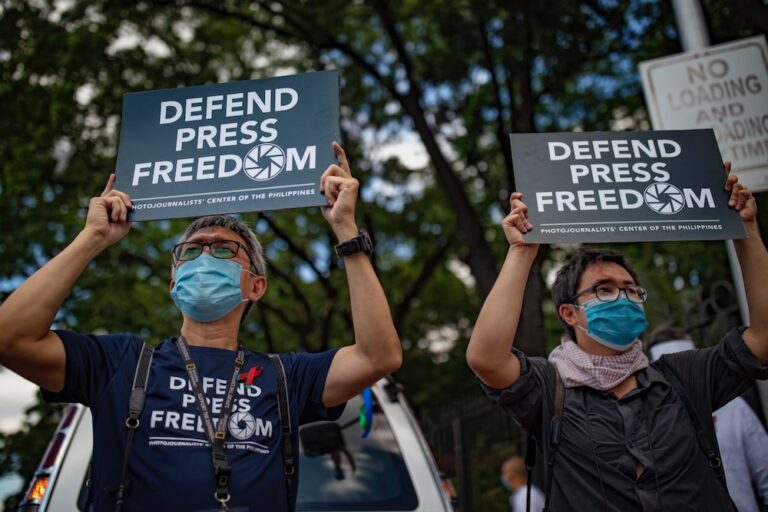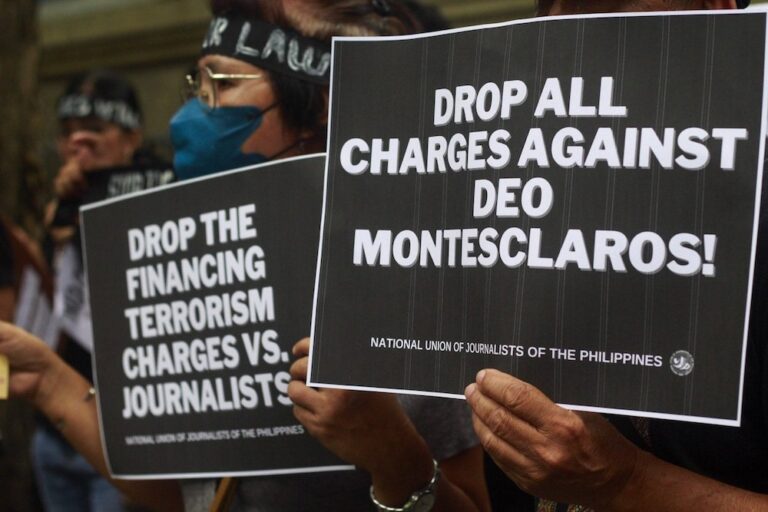Media watchdogs have documented 184 cases of attacks targeting journalists under the incumbent government.
This statement was originally published on cmfr-phil.org on 3 May 2025.
THE STATE of media freedom in the Philippines presents the continuing paradox of a libertarian legal framework that protects freedom of expression and press freedom amid forces hostile to the objectives of journalism to create a truly informed community. Historic disruptions have affected the growth of the press in the Philippines.
The imposition of Martial Law in September 1972 lasted 14 years, ending only when the People Power uprising drove out Ferdinand E. Marcos in February, 1986, toppling the dictatorship that kept Marcos, his family, and cronies in power. Following a chain of democratic leaders through election, Rodrigo Duterte gained electoral victory in 2016, and exercised executive power to overwhelm legislative opposition and judicial checks, effectively restricting people’s freedom and civil liberties.
For six years, through actual practice and propaganda, Duterte’s implementation of his “war on drugs” mobilized police and law enforcement agencies to act against citizens. The experience showed how easily an elected chief executive could move away from established democratic processes and resort to repression. Duterte presided as a despot, employing terror tactics through speech and action. He demonstrated the extent to which state forces can turn on citizens.
Duterte’s actions continue to cloud the exercise of press freedom. Although, the election of Ferdinand Marcos Jr. to the presidency turned the page from the most egregious measures employed by the Duterte administration; repressive actions continue, deployed selectively by law enforcement agencies, using more subtle, less visible institutional mechanisms, making these more difficult to challenge.
The government has responded with a range of actions to check activism: red-tagging, surveillance, legal intimidation, and online harassment were the official weapons of choice.
From July 1, 2022, to April 30, 2025, documentation by the Center for Media Freedom and Responsibility (CMFR) and the National Union of Journalists of the Philippines (NUJP) showed the rise of attacks against media workers: the 184 cases exceeded the record of 128 logged under Duterte. The numbers reflect an increase of 44 percent.

Intimidation emerged as the most common form of attack, with 85 cases recorded, including 48 cases of red-tagging and 19 instances of surveillance. Harassment, whether physical, verbal, or online, accounted for 33 cases. There were 18 cyberattacks targeting news organizations, primarily distributed denial-of-service (DDoS) attacks and social media takedowns. Thirteen journalists faced cyber libel charges. Ten received death threats. Nine cases involved censorship, including coverage bans. Six journalists were arrested. Four separate incidents involved shootings and a bombing of a journalist’s property.
The nationwide perspective deepens the sense of exerted pressures. Geographically, Metro Manila recorded the majority of incidents, a total of 95 attacks and threats, followed by Eastern Visayas with 21, and the Bicol Region with 16. CMFR noted that these areas were also the hotspots for media attacks during the Duterte administration.
Online platforms were the most frequent targets, with 80 cases, trailed by radio (39), television (29), and print (21). The concentration of these attacks in both digital and traditional platforms underscores the breadth of the threat impact, calling the need for measures that provide sector-focused defense and protection.
Involvement of State agents as perpetrators
The cases show the continuing involvement of state forces in the perpetration of checks and restrictions.
Of the 184 cases, 78 or 42 percent involved state actors. Notably, 11 incidents were linked to officials of the previous administration who continued to intimidate media workers even after their terms, underscoring the continued application by the current administration of President Marcos Jr. of the same repressive strategies employed by the previous administration.

Fewer journalists killed but. . .
The Marcos Jr. administration has noted the decline in journalist killings as evidence of progress; as the 2024 report from the Committee to Protect Journalists (CPJ), has reported zero work-related journalist deaths last year.
But the absence of killings should not mislead stakeholders, as the quality of press freedom must be measured by other valuations.
Media freedom and its full practice must proceed in an environment free of the fear of reprisal.
The five journalists killed since Marcos Jr. took office include: Rey Blanco on September 18, 2022; Percy Lapid on October 3, 2022; Cresencio Bundoquin on May 30, 2023; Ma. Vilma Rodriguez on October 22, 2024 (whose death has not been officially recognized as work-related); and Juan “Johnny” Dayang on April 30, 2025.
While lower than the number under Duterte’s watch, these media killings build up the pattern of government action against journalists.
The requisite review must take into account the low rate of conviction, as well as the low number of cases taken to court; both are clear signals of the enduring culture of impunity.
Since 1986, when the change of government restored press freedom in the country; over 170 journalists have been killed in the Philippines, suggesting a more complex context to the threats and attacks against the free press and the safety of journalists. Of this number, only 50 convictions have been secured by the judicial system; 31 of these were connected to the Ampatuan Massacre case. Of the 93 cases to reach court, 39 were dismissed, 36 ended in acquittals, and 9 were archived.
These statistics reveal the slow pace of justice to satisfy not just journalists who are killed or besieged as a result of their work. Media advocacy seeks justice for all as its end goal, fully aware that the success it attains for the cases of journalists killed or otherwise attacked will benefit the broader struggle for justice for all citizens.
Journalists and media practitioners, after all, are probably better known than ordinary citizens, as their work is done in high visibility. Efforts to gain justice for journalist victims and their survivors will serve the larger objective of fostering a culture of justice, a culture of awareness that grows in an environment of free media, providing as much news about the state of the press and its practice.
The study of attacks and threats opened for media watchdog organizations a panoramic view of the failure of justice in the prosecution of other forms of violence, especially when these are perpetrated by those who have been elected or appointed to power. The situation suggests the misconception of the purpose of public office, the abuse of such power, and the making of victims of so many unknowing and uninformed Filipinos.
At this point, survey reports on attacks and threats have yet to document the identification of suspects and masterminds, and the rate of success with which the courts have brought these perpetrators to justice.
Institutional red-tagging and the anti-terrorism apparatus
Red-tagging remains one of the most frequently reported threats to journalists in the country. The understanding of how such a threat places journalists at risk is crucial to developing an effective response.
First institutionalized in 2018 under Duterte through the National Task Force to End Local Communist Armed Conflict (NTF-ELCAC), it has since gained further legitimacy with the Anti-Terrorism Act of 2020. The law has been criticized for its vague definition of terrorism and provisions that allow authorities to label individuals or groups as terrorists, potentially with limited evidence. Critics argue that this poses risks to civil liberties and may be used to target dissent, including journalists critical of the government.
One prominent example is Frenchie Mae Cumpio, a community journalist and executive director of Eastern Vista, who was arrested in February 2020 on charges of illegal possession of firearms and explosives — allegations frequently made against red-tagged individuals. Despite international condemnation and continued calls for her release, she remains in detention, her case emblematic of how the legal system is used to criminalize dissent and silence grassroots journalism.
In a rare legal victory, the Supreme Court ruled on May 8, 2024, in Siegfred Deduro v. Maj. Gen. Eric Vinoya, which finally recognized that red-tagging, vilification, and labeling can pose threats to life, liberty, and security. The ruling was based on a writ of amparo filed by Deduro, a former Bayan Muna lawmaker wrongfully accused of communist affiliations. The Court found prima facie evidence of state-inflicted harm and declared that red-tagging is not protected speech when it incites violence or state repression.
The Commission on Human Rights hailed this as a landmark decision that reaffirms constitutional protections and strengthens the writ of amparo as a remedy for those under threat.
This legal precedent was reinforced on April 8, 2024, when the Quezon City Regional Trial Court ruled in favor of journalist Atom Araullo, who had filed a civil case against former NTF-ELCAC spokespersons Lorraine Badoy-Partosa and Jeffrey “Ka Eric” Celiz. Araullo was awarded PHP2 million in moral and exemplary damages after the court concluded that the defendants had abused their right to free speech and engaged in defamatory, dangerous conduct.
The decision was a rare moment of achieving accountability for red-tagging, a practice that has become quite common among those seeking ways of restraining critics of government and public officials.
Turning numbers into action
The documented 184 cases of media attacks serve not just as a record, but a call to action. To preserve a free press in the Philippines, CMFR recommends that the government and relevant institutions take the following steps:
- Sustain the pursuit of justice for past cases. Reopen and expedite unresolved journalist killings since 1986. Ensure transparency and impartiality, particularly in the more than 120 cases still lacking convictions.
- Strengthen the capacity for prompt prosecution. Equip prosecutors and law enforcement officers with learning resources and training for effective handling of media-related cases, which involve constitutional rights and freedoms. Establish a specialized unit within the Department of Justice focused on press freedom violations.
- Protect at-risk journalists. Implement a multi-sectoral program for national protection that includes legal aid, emergency support, relocation assistance, and digital security for journalists under threat.
- Dismantle the state’s red-tagging apparatus. Enforce penalties for red-tagging by state actors, especially within NTF-ELCAC. Uphold constitutional rights and align domestic laws with international human rights standards.
- Institutional reform and transparency. Mandate regular public updates on the status of investigations into journalist attacks. Promote independent oversight and civil society participation in monitoring government accountability.
- International oversight and solidarity. Pursue cooperative activities to involve global press freedom bodies, human rights groups, and the United Nations to maintain international pressure for reforms.
Press freedom as an election issue
Amid another election cycle, the Philippines must highlight the value of press freedom in the national conversation as the media and its conduct exert its influence and impact on other policy concerns and issues. The defense of press freedom must be part of the national discussion. The vote should not merely reflect economic or policy preferences; it must also reflect a choice of the fundamental values that define our way of life. Truth and transparency require the public as voters to be informed about the conduct of those who are elected to positions of power. Journalists and their right to report safely are crucial to all citizens, as their capacity of citizens to be informed depends on the capacity of media workers to deliver the news without danger to themselves.
Freedom of the press is not a privilege for media workers; it is not for their sole benefit. It is tied to the right of the people to knowledge and information that enables their practice with public support for the service journalism provides. News makes people aware and draws them to discussions with others, enlivening a national conversation about the concerns and issues that affect their lives. The press is a crucial instrument of a society to ensure that indeed citizens are informed enough so they can contribute to the exchange of ideas about the future we want for ourselves, the kind of nation that we want to build, not just for ourselves but for generations yet to come.
A quick review of coverage of TV and print platforms also shows the need for more critical reporting, that is done by the press as whole, with more press organizations investing in the effort to criticize and evaluate the conduct of government power. While there have been investigative reports to check and expose wrongdoing and malfeasance in places of power, these have not matched the record set in other periods by investigative journalists.
This may have to do with the radically changed environment of news reporting and delivery, a concern which deserves some discussion by stakeholders. Without a free and fearless press, democracy dies in silence.
This report is based on consolidated data from the Center for Media Freedom and Responsibility (CMFR) and the National Union of Journalists of the Philippines (NUJP). Figures may vary slightly due to differences in documentation methods.



